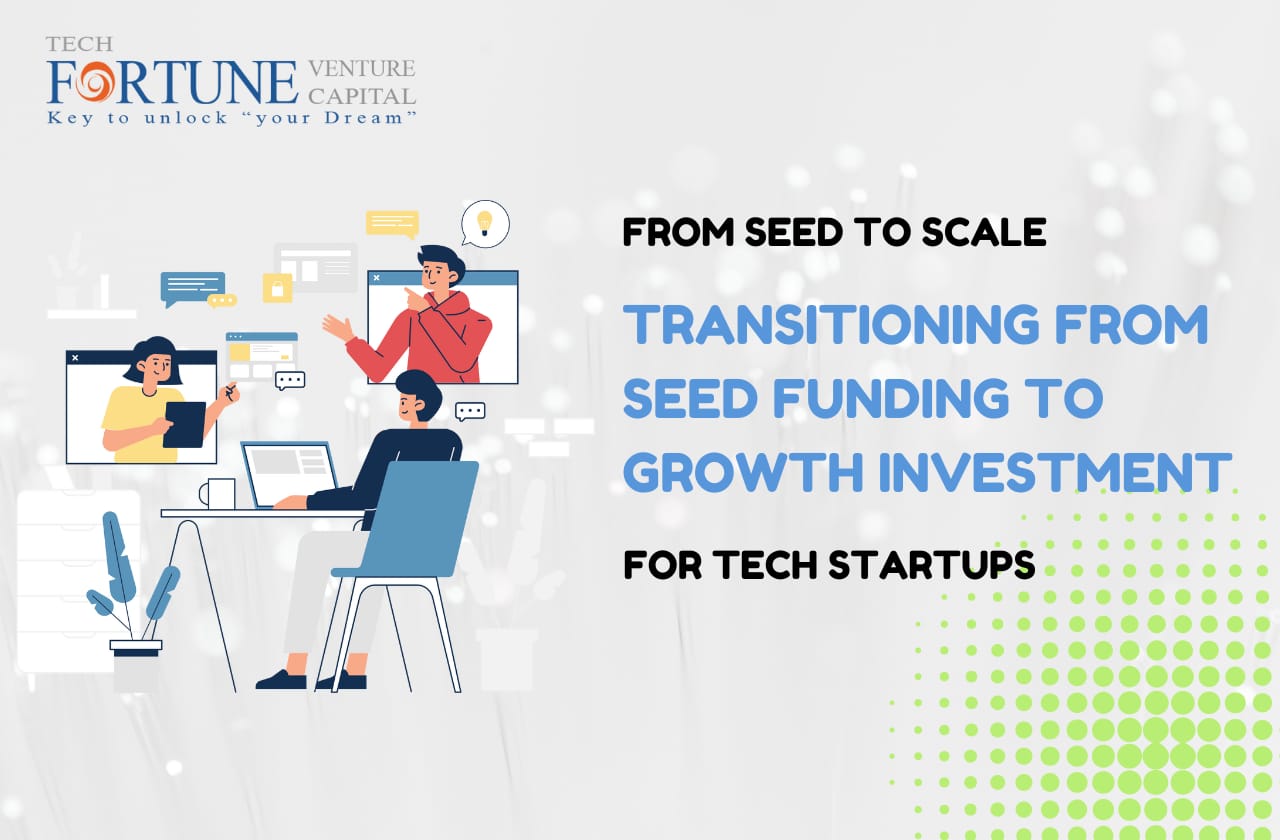“From Seed to Scale: Transitioning from Seed Funding to Growth Investment for Tech Startups”
“Grow Beyond Limits: Mastering the Art of Scaling Your Startup!“
Navigating the journey of a tech startup from seed funding to growth investment is a complex yet exhilarating process. As a startup evolves, its needs change significantly, requiring a strategic approach to secure the necessary capital for growth. Understanding the transition from seed funding to growth investment is crucial for founders aiming to scale their operations and maximize their potential. This blog will explore the stages of funding, the critical steps involved in transitioning, and best practices for attracting growth investment.
Understanding the Funding Stages
Seed Funding: The Launchpad
Seed funding serves as the initial capital that helps entrepreneurs develop their business idea, conduct market research, and build a prototype. This early-stage funding typically comes from personal savings, friends and family, angel investors, or early-stage venture capital firms. The primary goal of seed funding is to validate the startup concept and reach critical milestones, such as achieving product-market fit.
During this stage, it’s essential for startups to:
- Focus on Market Validation: Understand customer needs and refine the product offering based on feedback.
- Build a Minimum Viable Product (MVP): Develop a basic version of the product to test in the market.
- Establish a Strong Team: Assemble a team with complementary skills to drive the business forward.
Growth Investment: Fueling Expansion
Once a startup has successfully navigated the seed funding phase and demonstrated product-market fit, it can begin seeking growth investment. Growth capital typically comes from venture capital firms, private equity, or strategic investors. This funding is intended to scale the business by expanding operations, entering new markets, and enhancing marketing efforts.
Key objectives for securing growth investment include:
- Scaling Operations: Increase production capabilities to meet rising demand.
- Market Expansion: Enter new geographic markets or customer segments.
- Product Development: Enhance existing products or develop new offerings to remain competitive.
Transitioning from Seed to Growth: A Strategic Approach
1. Assess Your Business Model
Before seeking growth investment, evaluate your business model to ensure it is scalable and sustainable. Investors want to see a clear path to profitability, so focus on demonstrating how your business can grow and generate returns. Key aspects to consider include:
- Revenue Streams: Diversify your revenue sources to reduce risk.
- Customer Acquisition Cost (CAC): Ensure your CAC is manageable relative to the lifetime value (LTV) of your customers.
- Operational Efficiency: Streamline operations to improve margins and maximize profits.
2. Strengthen Your Value Proposition
A compelling value proposition is vital in attracting growth investors. Clearly articulate what sets your product or service apart from the competition and how it addresses specific customer pain points. Emphasize any unique technology, intellectual property, or market insights that give your startup a competitive edge.
3. Build a Track Record
Investors prefer startups with a proven track record. As you transition from seed funding to growth investment, focus on achieving key performance indicators (KPIs) that demonstrate your business’s potential. Track metrics such as:
- Revenue Growth: Show consistent increases in revenue over time.
- Customer Retention Rate: Highlight your ability to retain customers and build loyalty.
- Market Penetration: Provide evidence of your startup’s growing market presence.
4. Develop a Comprehensive Growth Strategy
A well-defined growth strategy is essential for convincing investors of your startup’s potential. Outline your plans for scaling the business, including marketing initiatives, operational improvements, and potential partnerships. Consider the following components:
- Target Market Analysis: Identify and prioritize the markets you intend to enter.
- Marketing Strategy: Develop a robust marketing plan that includes digital marketing, content creation, and customer outreach.
- Operational Plan: Detail how you will scale operations, including hiring, production, and supply chain management.
5. Prepare for Due Diligence
As you approach potential investors, be prepared for the due diligence process. Investors will scrutinize your financials, operations, and market position. To streamline this process, ensure you have the following:
- Financial Statements: Maintain accurate and up-to-date financial records, including profit and loss statements, cash flow projections, and balance sheets.
- Legal Documentation: Organize all legal agreements, contracts, and compliance documentation.
- Market Research: Provide data supporting your market opportunity and competitive landscape.
6. Network and Build Relationships
Building relationships with potential investors is crucial in securing growth investment. Attend industry events, pitch competitions, and networking functions to connect with venture capitalists and other investors. Engaging with mentors and industry experts can also provide valuable insights and introductions.
7. Tailor Your Pitch
When approaching investors for growth funding, tailor your pitch to align with their interests and investment thesis. Highlight your startup’s achievements, future growth potential, and how their investment will contribute to scaling the business. Key elements to include in your pitch are:
- Problem and Solution: Clearly articulate the problem your startup solves and how your product addresses it.
- Market Opportunity: Provide data on market size, growth potential, and competitive landscape.
- Financial Projections: Present realistic revenue projections, outlining how the investment will be utilized to achieve growth.
8. Consider Alternative Funding Options
In addition to traditional venture capital, explore alternative funding options that may better align with your business needs. Options include:
- Convertible Notes: These are debt instruments that convert into equity upon a future financing round.
- Revenue-Based Financing: A form of funding where investors receive a percentage of revenue until a predetermined amount is repaid.
Crowdfunding: Platforms like Kickstarter or Indiegogo allow startups to raise funds from a large number of small investors.
Best Practices for Attracting Growth Investment
- Build a Strong Brand Presence: Invest in branding and marketing efforts to establish your startup as a trusted player in your industry.
- Demonstrate Adaptability: Show potential investors that your startup can pivot and adapt to changing market conditions or customer needs.
- Engage Advisors: Having experienced advisors on your team can enhance credibility and provide valuable guidance throughout the growth phase.
- Focus on Customer Success: Prioritize customer satisfaction and success, as happy customers can lead to referrals and increased revenue.
Wrap Up:
“Invest in Your Future: Transitioning to Growth Made Simple!”
Transitioning from seed funding to growth investment is a pivotal moment in the life of a tech startup. By understanding the funding landscape, assessing your business model, and preparing strategically for growth, you can navigate this transition successfully. The journey may be fraught with challenges, but with the right approach and a focus on building a sustainable and scalable business, your startup can achieve remarkable success. As you prepare for growth investment, remember that it’s not just about securing funds; it’s about building lasting relationships and setting your startup up for long-term prosperity.
In conclusion, transitioning from seed funding to growth investment is a crucial phase for tech startups aiming for scalability and long-term success. Techfortune Venture Capital understands the unique challenges faced during this journey and offers tailored support to navigate them effectively. With a keen focus on fostering innovation and ensuring strategic alignment, we empower startups to attract the right investors and implement growth strategies that drive sustainable expansion. Partner with Techfortune to unlock your startup’s full potential and make a significant impact in the tech landscape. Together, we can turn your vision into a thriving reality.
Did you know?
According to recent stats, Startups backed by venture capital often grow revenue 3 times faster than those without VC support.
FAQ:
Startups should avoid overvaluation, lacking a clear business model, poor financial planning, and failing to validate their product in the market.
A compelling pitch should include a clear value proposition, a solid business model, market analysis, traction evidence, and a defined growth strategy.
A realistic valuation helps attract the right investors, builds credibility, and sets a solid foundation for future funding rounds without deterring potential backers.
After securing seed funding, startups should prioritize product development, achieving product-market fit, building a strong team, and maintaining communication with investors.

